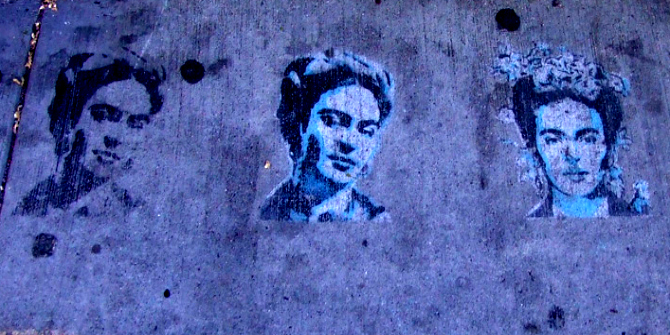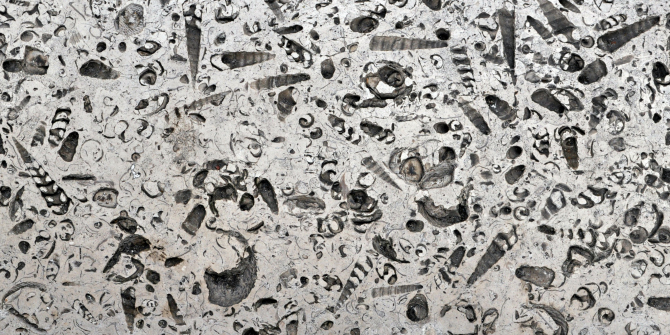In Surrealism in Egypt: Modernism and the Art and Liberty Group, Sam Bardaouil provides the first comprehensive account of the Egypt-based Surrealist collective’s artworks, literary texts and critical writings. This is an innovative analysis that invites us to reconsider existing definitions and understandings of the Surrealist movement, balancing detailed historical inquiry with provocative theoretical questioning, writes Johannes Makar.
Surrealism in Egypt: Modernism and the Art and Liberty Group. Sam Bardaouil. I.B. Tauris. 2016.
Find this book (affiliate link): ![]()
 In Surrealism in Egypt: Modernism and the Art and Liberty Group, Sam Bardaouil sets out to delineate the trajectory of the Egypt-based Surrealist group ‘Art and Liberty’ (al-Fann wa al-Hurriya – Art et Liberté). Neither ‘imitators of a European movement’ nor ‘upholders of an Egyptian identity’, Bardaouil examines Art and Liberty’s (henceforth AL) contributions outside familiar paradigms and ultimately returns to a fundamental question concerning the historiography of Surrealism globally – how can we reconstruct an alternative canon ‘without forcing the art history of the marginal to operate in tandem with that of the dominant center’ (237)? Unfolding over eight chapters, Bardaouil offers an innovative account of the Surrealist movement in Egypt, with implications for the way we more generally construe cultural transfers beyond their immediate geo-temporal context.
In Surrealism in Egypt: Modernism and the Art and Liberty Group, Sam Bardaouil sets out to delineate the trajectory of the Egypt-based Surrealist group ‘Art and Liberty’ (al-Fann wa al-Hurriya – Art et Liberté). Neither ‘imitators of a European movement’ nor ‘upholders of an Egyptian identity’, Bardaouil examines Art and Liberty’s (henceforth AL) contributions outside familiar paradigms and ultimately returns to a fundamental question concerning the historiography of Surrealism globally – how can we reconstruct an alternative canon ‘without forcing the art history of the marginal to operate in tandem with that of the dominant center’ (237)? Unfolding over eight chapters, Bardaouil offers an innovative account of the Surrealist movement in Egypt, with implications for the way we more generally construe cultural transfers beyond their immediate geo-temporal context.
‘Art – as a permanent spiritual and emotional exchange between all of humanity – can no longer be bound by such arbitrary [national] limits’ (245). These words, extracted from AL’s 1938 Arabic-French manifesto, Yahya al-fann al-munhatt/Vive l’art dégénéré, capture one of the group’s central objectives. Amidst intensifying fascist sentiment and at a time when artists were implicated in the parading of state power, AL was born of the desire to transcend the limits imposed on artistry by nationalism and cultural patrimony. Relying on Communist Internationalism and Freudian techniques of free association to achieve art’s liberation (as well as that of society), AL developed a distinct aesthetic aimed at breaking down social barriers, ridding art of its bourgeois esotericism and welcoming viewers into their space of creation. For instance, Bardaouil discusses AL’s use of the exhibition space, which it infused with subversive messages and opened up to a wider audience to produce a ‘transfer of agency’ to the exhibition visitor.
Throughout the book, Bardaouil is keen to highlight the Surrealist group’s internationalist orientation and carefully documents the artists’ diverse backgrounds. Brought together by conditions of war and humanitarian crisis, AL encompassed an amalgam of Egyptians and non-Egyptians who worked closely together in a ‘process of stimulation and appropriation’ (105). Indeed, AL conceived of a sphere of creativity that dismissed not only national difference, but also minimised the gap between literary and pictorial modes of artistic expression. To cite a prominent example, AL’s co-founder Georges Henein’s war poetry fuelled the imagination of fellow group members Kamel el-Telmisany, Ramses Younane and Inji Efflatoun. In interpreting Henein’s work visually – through their paintings, novels and other creative works – they added shades and tones to Henein’s writings, thus collectively producing a style that was imbued with poetic imagery and distinctly dialogical.
Besides shedding light on the group’s activities, Bardaouil charts AL’s connections to the international network of Surrealists. The author calls attention to their shared anti-fascism and dissatisfaction regarding the bourgeois notion of ‘art for art sake’, but emphasises that AL did not partake in the Surrealist project without altering its texture. Through a meticulous analysis of previously unpublished correspondence, Bardaouil shows how AL, in contrast to previous claims (see, for example, Don LaCoss), grew out of specific local concerns, leading them to disagree on urgent theoretical matters with movements including the International Federation of Independent Revolutionary Art (F.I.A.R.I.). Equally compelling is Bardaouil’s assessment of the notions of ‘subjective realism’ (Rames Younane) and ‘free art’ (Kamil al-Telmisany), which emerge as part of the group’s efforts at renegotiating Surrealism’s conceptual parameters as well as, crucially, reinvigorating its call for revolution. For AL, as Bardaouil puts it:
the true artist is one who creates an art that is first and last consumed by Humanity (with a capital H) not the individual, Existence (with a capital E) not citizenship, and the Universe (with a capital U) not the nation (138).
Bardaouil consequently encourages us to reconsider the very definition of Surrealism: ‘to write a history of the Art and Liberty Group is to imagine anew the definition, expression, and the canon of Surrealism’ (236). Rather than the European movement it is often portrayed to be, Surrealism emerges as a crowd of international artists who, while occupying varying and evolving ideological positions, partnered in a shared struggle to bring about revolutionary change. For AL, this culminated in efforts aimed at surmounting a theoretical contradiction between Hegelianism and Marxism à propos the relationship between abstract thought and empirical matter, leading the art collective to diverge from other Surrealist groups, notably the Paris-based Bretonian circle. This development, among others, prompts Bardaouil to call for a more nuanced understanding of Surrealism – one that sets the movement free from a priori uncontested labels and contributes to:
an inclusive vision of art history where the particularities of the peripheral are no longer seen as dichotomous with the authority of the central, and perhaps even to an extent where such oppositions are no longer visible (243).
For this reason, the author himself is cautious neither to implicate AL in contemporary polemics within the Saidan and postcolonial paradigm nor depict its legacy as a passage in Arab art history. Drawing on Erwin Panofsky’s notion of aesthetic re-creation, he argues that contemporary debates would polarise its legacy and add salience to an identity politics that the group never invited.
While Surrealism in Egypt enthrals, questions linger. At times, AL’s ideological position appears marred by inconsistencies, which Bardaouil leaves undiscussed. For one, the place of ‘the national’ remains ambiguous within AL’s discourse. Despite the group’s adamant rejection of the ‘alignment of art with nationality’, it too reverted to a political vocabulary that re-inscribed (rather than overhauled) a national imaginary. Thus, when Georges Henein clarifies the group’s internationalism in 1940 by arguing ‘Art has no homeland, no territory. Chirico is not more Italian than Delvaux is Belgian, Diego Rivera is Mexican, Tanguy is French, Max Ernst is German or Telmisany is Egyptian’ (267), his view of the world seems an inversion of the prevailing one – one that corroborates the nation-state as a unit of analysis in a call for a universal albeit territorially-indexed humanism, not a revolutionised worldview that transcends geographical frontiers and renders the nation-state illusory. Perhaps the group’s ambivalence also helps explain why its revolutionary ambitions ultimately dissolved in the face of new attempts to unite art and nationality circa 1945. Again, however, Bardouil does not take up this critical point.
Yet, there should no doubt about the value of Surrealism in Egypt. The book is dedicated to unearthing the history of AL on its own accord, and it achieves this task with convincing clarity. Bardaouil carefully balances his historical inquiry with provocative theoretical questions that will garner the interest of scholars of modern art in Egypt and art theorists alike. Another testimony to the book’s resourcefulness are the images and excerpts of paintings, archival documents, printed materials and photographs, which add important visual impressions to this rich text. It is also worth mentioning that the book’s publication trails two exhibitions putting on display AL’s work – one co-curated by Bardaouil himself touring Paris, Madrid, Dusseldorf and Liverpool; the other organised by the Emirates-based Sharjah Art Foundation. Presenting two differing views, with the former echoing the book’s narrative and the latter celebrating AL’s work as an example of ‘Egyptian Surrealism’ (a notion Bardaouil defies), this book is a potent reminder that a historical narration of the Art and Liberty group is best approached as an open-ended story: far from settled and resisting fixity, it will continue to provoke questions about an art history still in the making.
Note: This review and interview gives the views of the author, and not the position of the LSE Review of Books blog, or of the London School of Economics and Political Science.The LSE RB blog may receive a small commission if you choose to make a purchase through the above Amazon affiliate link. This is entirely independent of the coverage of the book on LSE Review of Books.







